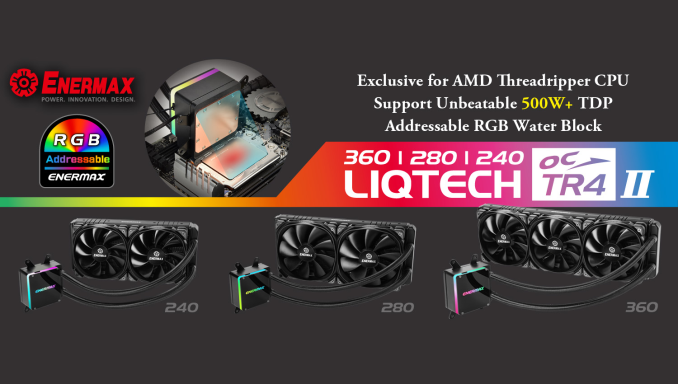Enermax Unveils LiqTech TR4 II LCS: A 500W TDP Threadripper 2 Cooler
by Anton Shilov on August 13, 2018 5:00 PM EST- Posted in
- Water Cooling
- AMD
- Enermax
- LiqTech TR4

Enermax on Monday introduced its new LiqTech TR4 II closed-loop liquid cooling systems, which are designed for use with AMD’s latest Ryzen Threadripper 2 processors. Just like its predecessor, the new LCS covers 100% of processor’s IHS surface and can dissipate up to 500 W, which is well above AMD’s official 250W TDP specification. And following the latest trends, the new lineup also features addressable RGB LEDs.
The new Enermax LiqTech TR4 II Threadripper 2 lineup consists of LCSs featuring 360, 280, and 240 mm radiators outfitted with multiple fans of appropriate sizes. Being aimed primarily at AMD’s latest Ryzen Threadripper 2 processors, the coolers can dissipate an excessive amount of heat. Enermax is rating the coolers to remove up to 500 Watts of heat, which is twice (or more) the processors' official TDP.
Architecturally, the new LiqTech TR4 II feature the company’s micro-channel-based design with a shunt channel (the firm calls it SCT) that maximizes cooling performance, something that the original LiqTech TR4 AIO AIO cooler did as well. Meanwhile, the main difference between the two LCSes are addressable RGB LEDs featured on the latest models. The LEDs are controllable using a control box that the manufacturer supplies as well as software from makers of motherboards (yet, Enermax does not say which ones).
Enermax plans to start sales of the LiqTech TR4 II LCS this month. The top of the range 360mm model costs $160 at leading retailers like Newegg. Others will start at $140.
Related Reading:










9 Comments
View All Comments
cyberguyz - Monday, August 13, 2018 - link
I really hope Enermax has resolved the poor quality coolant they used in these. I have seen pictures of the organic crap & corrosion on the waterblock and pump after a few months on the first release of these. It was pretty disgusting. For those that don't know Enermax uses a solid copper cold plate and aluminum radiator. Veterans like myself that liquid cool know that you don't mix an anodic metal (copper) and a cathodic metal (aluminum) in the same loop due to galvanic corrosion. To combat that you need a very strong corrosion inhibitor and biocide in the coolant to keep the organic growth down.eek2121 - Monday, August 13, 2018 - link
Enermax used aluminum for the fins, not necessarily for the radiator itself. There are several radiators that are designed exactly like this. Water does not run through the fins. What you said about the liquid coolant used is true however.rpg1966 - Tuesday, August 14, 2018 - link
Is the coolant conductive?UnNameless - Tuesday, August 14, 2018 - link
If water doesn't touch the different metals how is galvanic corrosion taking place then?!megadirk - Tuesday, August 14, 2018 - link
A copper cold plate and an aluminum radiator is a combination used in a vast amount of Asetek manufactured AIO's. The fluid used in these are formulated for anti corrosion, thus why most are bright green in color if you drain them. The first gen Liqtech didn't go so well as far as reliability goes but from Gamers Nexus' tear down it doesn't seem to be from doing things differently then most other AIO's. https://youtu.be/5i4_kI_FTG8JoeyJoJo123 - Tuesday, August 14, 2018 - link
All the CLCs, even the popular Asetek ones, have a copper cold plate and an aluminum radiator. That's exactly why the CLCs can hit aggressively low pricepoints to have near parity value to tower air coolers.You can use an aluminum fin radiator and copper cold plate for several years without major issues. I'm not saying the first Enermax Liqtech TR4 was devoid of issues, but simply blaming copper coldplate + aluminum fin radiator as the problem isn't really accurate since there are plenty of other copper coldplate + aluminum fin radiator asetek CLCs on the market without those issues.
Spatty - Tuesday, August 14, 2018 - link
In the process of returning my 2nd set of the 1st version...these will probably be junk too.glavatron - Wednesday, September 19, 2018 - link
Sadly, I can almost guarantee that they will be. I went through quite a few of them before I gave up.Maybe it's the fluid they used but whatever the cause is, they all corrode and/or form organic material. The system clogs up and it fails to cool the CPU.
glavatron - Wednesday, September 19, 2018 - link
Hopefully, Liqtech II fixes this.